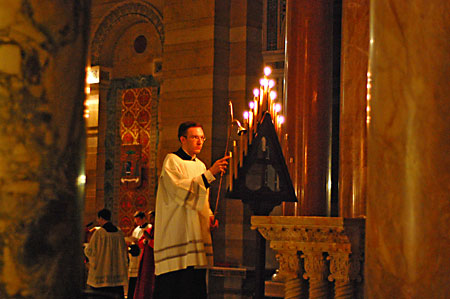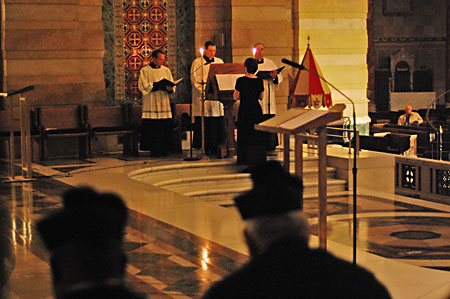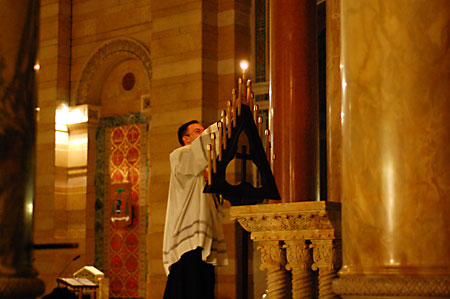I have had more than a few people ask me about the purpose, meaning, etc. of the ancient Tenebrae (latin for 'darkness' or 'shadows') service held during the Easter Triduum, especially after hearing we've re-started the tradition of having all the Seminarians, together with the Archbishop, pray this office every year on the eve of Good Friday at the Cathedral Basilica of Saint Louis.
Here's a basic explanation of the Ancient Office of Tenebrae, found on the programs we were given this year:
The name Tenebrae, meaning darkness or shadows, has for centuries been applied to early morning offices of Matins and Lauds of the last three days of Holy Week, which in the middle ages came to be celebrated on the preceding evenings. The most conspicuous feature of the service is the gradual extinguishing of candles and other lights in the church until only a single candle, considered a symbol of the Lord, remains. Toward the end of the services, this candle is hidden typifying the apparent victory of the forces of evil. At the very end, a strepitus ("loud noise") is made, symbolizing the earthquake at the time of the resurrection, the hidden candle is restored to its place, and by its light all depart in silence.
This Tenebrae services is divided into two parts. The first part of the services is the moern Office of Readings (Matins) for Holy Thursday. Documents from the Second Vatican Council encourage the use of the Office of Readings and the other hours from the Liturgy of the Hours to be celebrated on the most solemn of days in the cathedral church.
The second part makes use of the major elements from the ancient Office of Tenebrae arranged in devotional form. The Lamentations with their Hebrew alphabetical organization, Latin Responsories with their Gregorian melodies, the Benedictus from Lauds and the Lord's Prayer and Miserere which are softly spoken are all retained from the medieval liturgy.
For our prayer, we began as we would always begin any of the regular Hours in the Liturgy of the Hours, with an invitatory verse and response, then a hymn, and then the psalmody (which includes an antiphon, then a psalm, then the same antiphon... then another antiphon, a psalm, etc.). In between each of the psalms, and all the readings that followed (taken from the Office of Readings), one of the seminarians would put out one of the 14 candles:

After two readings and responsories, there is a prayer, and then begins the 'Lamentations,' three lessons with responsories in-between. Finally, the canticle of Zachariah (or 'Benedictus' from the Lauds) is chanted, the Christus Factus est and Our Father is prayed, and Psalm 51 (the Miserere) is sung (in our celebration, five seminarians would chant parts, while the full Archdiocesan choir would sing the others—it was quite beautiful!).

During the Christus Factus est, the last candle is carried behind the altar (to represent the light of Christ being seemingly gone after Jesus' death) by the seminarian who attends to the candles:

After Psalm 51, the Archbishop recites the closing prayer in a low voice, then the strepitus ('loud noise') is made (in our celebration, all the seminarians sitting in the choir stalls on either side of the main altar used old hymnals to beat on the wooden choir stalls, making quite a noise in the Cathedral!), and the last candle is replaced on the top of the candle stand. All present depart in silence (something I wish happened in churches for regular services!).
The ancient office of Tenebrae is a very beautiful and moving way to finish Holy Thursday and prepare for good Friday. Especially after hearing the miserere sung well, I am put in the perfect mood for contemplating the mysteries of the Paschal Mystery during the rest of the Easter Triduum. I would recommend that anyone who has the opportunity of attending the office of Tenebrae goes to it; many places hold some form of Tenebrae or another.
Further Reading
- Catholic Encyclopedia: Tenebrae [New Advent]
- Catholic Devotions: Tenebrae [Sisters of Carmel]
- Tenebrae (service) [Wikipedia]